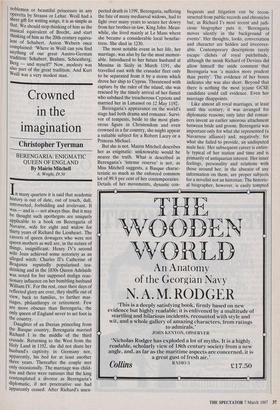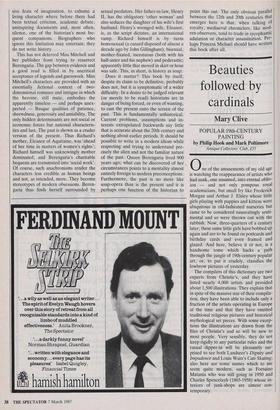Crowned in the imagination
Christopher Tyerman
BERENGARIA: ENIGMATIC QUEEN OF ENGLAND By Mairin Mitchell
A. Wright, f9.50
In many quarters it is said that academic history is out of date, out of touch, dull, introverted, forbidding and irrelevant. It was — and is — not always thus. But it may be thought such apothegms are uniquely applicable to a book on Berengaria of Navarre, wife for eight and widow for thirty years of Richard the Lionheart. The careers of queen dowagers who were not queen mothers as well are, in the nature of things, insignificant. Henry IV's second wife Joan achieved some notoriety as an alleged witch; Charles II's Catherine of Braganza reputedly popularised tea- drinking and in the 1830s Queen Adelaide was noted for her supposed malign reac- tionary influence on her bumbling husband William IV. For the rest, once their days of reflected glory are over, they shuffle out of view, back to families, to further mar- riages, philanthropy or retirement. Few are more obscure than Berengaria, the only queen of England never to set foot in the country.
Daughter of an Iberian princeling from the Basque country, Berengaria married Richard I in the middle of the third crusade. Returning to the West from the Holy Land in 1192, she did not share her husband's captivity in Germany nor, apparently, his bed for at least another three years. Thereafter the couple met only occasionally. The marriage was child- less and there were rumours that the king contemplated a divorce as Berengaria's diplomatic, if not procreative use had apparently ceased. After Richard's unex- pected death in 1199, Berengaria, suffering the fate of many mediaeval widows, had to fight over many years to secure her dowry from her brother-in-law, King John. Mean- while, she lived mainly at Le Mans where she became a considerable local benefac- tress. She died in 1230.
The most notable event in her life, her marriage, was also by far the most memor- able. Introduced to her future husband at Messina in Sicily in March 1191, she travelled east with the crusader fleet only to be separated from it by a storm which drove her ship to Cyprus. Threatened with capture by the ruler of the island, she was rescued by the timely arrival of her fiancé who subdued the treacherous Cypriots and married her in Limassol on 12 May 1192.
Berengaria's appearance on the world's stage had both drama and romance. Survi- vor of tempests, bride to the most glam- orous figure in Christendom and even crowned in a far country, she might appear a suitable subject for a Robert Lacey or a Princess Michael.
But she is not. Mairin Mitchell describes her as enigmatic: unknowable would be nearer the truth. What is described as Berengaria's 'intense reserve' is not, as Miss Mitchell suggests, a Basque charac- teristic so much as the enforced common lot of 99.9 per cent of her contemporaries. Details of her movements, dynastic con- bequests and litigation can be recon- structed from public records and chronicles but, as Richard I's most recent and judi- cious biographer puts it, 'Berengaria moves silently in the background of events'. Her thoughts, looks, conversation and character are hidden and irrecover- able. Contemporary descriptions rarely escape clichés of royal pulchritude, although the monk Richard of Devizes did allow himself the snide comment that Berengaria was 'a maiden more prudent than pretty'. The evidence of her bones indicates she was also short. Beyond that there is nothing the most jejune GCSE candidate could call evidence. Even her marriage disappoints.
Like almost all royal marriages, at least until this century, it was arranged for diplomatic reasons; only later did roman- cers invent an earlier amorous attachment between bride and groom. Berengaria was important only for what she represented (a Navarrese alliance) and, negatively, for what she failed to provide, an undisputed male heir. Her subsequent career is entire- ly typical of her station and time and is primarily of antiquarian interest. Her inner feelings, personality and relations with those around her, in the absence of any information on them, are proper subjects for a novelist not an historian. The historic- al biographer, however, is easily tempted sive feats of imagination, to exhume a living character where before there had been textual criticism, academic debate, uninspiring documents and, most often, silence, one of the historian's most fre- quent companions. Biographers who ignore this limitation may entertain; they do not write history.
This has not deterred Miss Mitchell and her publisher from trying to resurrect Berengaria. The gap between evidence and a good read is filled in by uncritical acceptance of legends and guesswork. Miss Mitchell's characters are provided with an essentially fictional context of two- dimensional romance and intrigue in which the heroine, still mute, embodies the apparently timeless — and perhaps unex- pected — Basque qualities of patience, shrewdness, generosity and amiability. The only hidden determinants are not social or economic forces but national characteris- tics and lust. The past is shown as a cruder version of the present. Thus Richard's Mother, Eleanor of Aquitaine, was 'ahead of her time in matters of women's rights'; Richard himself was unknowingly mother dominated; and Berengaria's charitable bequests are transmuted into 'social work': Of course, such anachronisms render the characters less credible as human beings and not, as intended, more. They become stereotypes of modern obsessions. Beren- garia thus finds herself surrounded by sexual predators. Her father-in-law, Henry II, has the obligatory 'other woman' and also seduces the daughter of his wife's first husband. Henry's wronged wife, Eleanor, is, as the script dictates, an international vamp. Richard himself is by turns homosexual (a canard disposed of almost a decade ago by John Gillingham), bisexual, mother-fixated, incestuous (both with his half-sister and his nephew) and pederastic; apparently little that moved in skirt or hose was safe. This, in short, is history as soap.
Does it matter? This book by itself, despite its claim to be definitive, probably does not, but it is symptomatic of a wider difficulty. In a desire to be judged relevant (or merely to be read) historians are in danger of being forced, or even of wanting, to cast the present onto the screen of the past. This is fundamentally unhistorical. Current problems, assumptions and in- terests extrapolated backwards say little that is accurate about the 20th century and nothing about earlier periods. It should be possible to write in a modern idiom while respecting and trying to understand pre- cisely the alien and not the familiar nature of the past. Queen Berengaria lived 900 years ago; what can be discovered of her circumstances points to a mentality almost entirely foreign to modern preconceptions. Furthermore, the past is no more like soap-opera than is the present and it is perhaps one function of the historian to point this out. The only obvious parallel between the 12th and 20th centuries that emerges here is that, when talking of royalty, mediaeval chroniclers, like mod- ern observers, tend to trade in sycophantic adulation or character assassination. Per- haps Princess Michael should have written this book after all.



























































 Previous page
Previous page